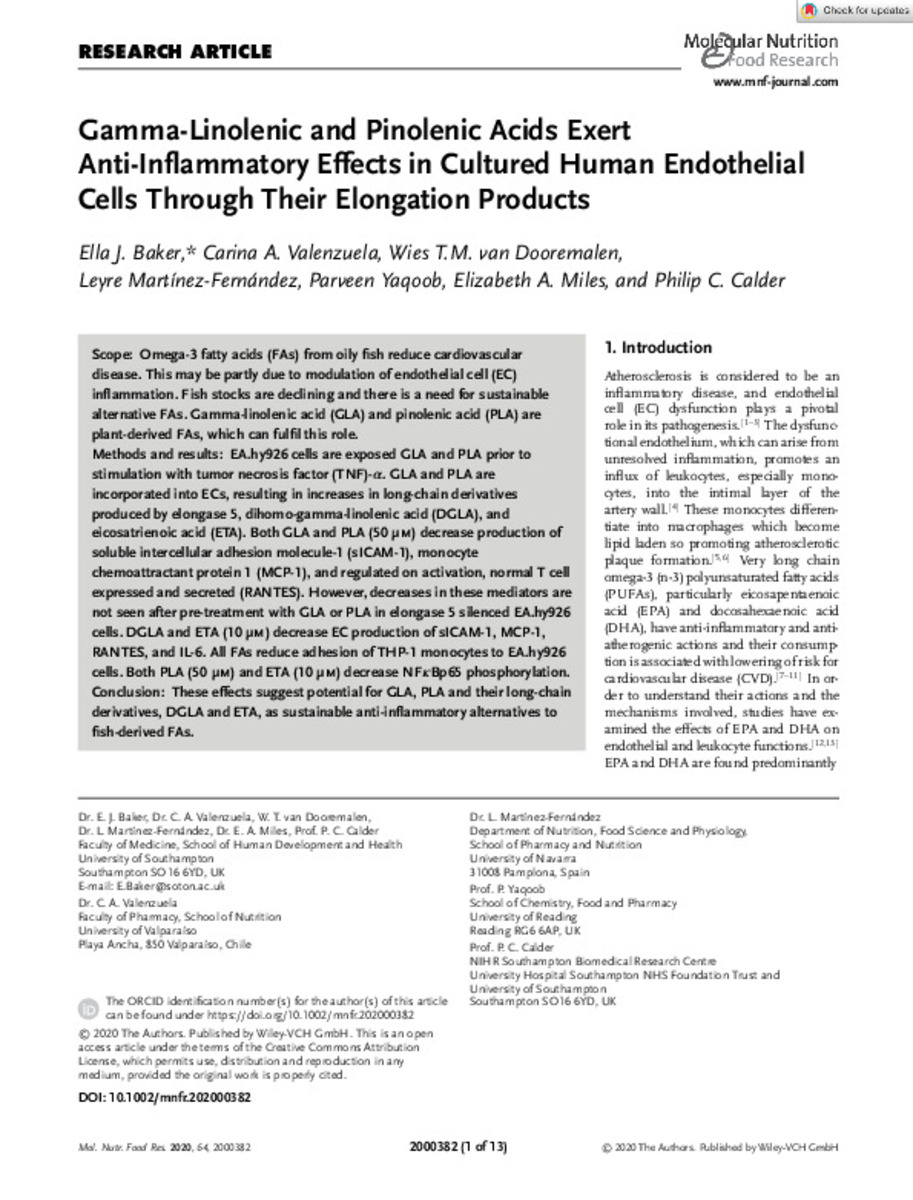Full metadata record
| DC Field | Value | Language |
|---|---|---|
| dc.creator | Baker, E.J. (Ella J.) | - |
| dc.creator | Valenzuela, C.A. (Carina A.) | - |
| dc.creator | van-Dooremalen, W.T.M. (Wies T.M.) | - |
| dc.creator | Martínez-Fernández, L. (Leyre) | - |
| dc.creator | Yaqoob, P. (Parveen) | - |
| dc.creator | Miles, E.A. (Elizabeth A.) | - |
| dc.creator | Calder, P.C. (Philip C.) | - |
| dc.date.accessioned | 2023-05-23T07:24:39Z | - |
| dc.date.available | 2023-05-23T07:24:39Z | - |
| dc.date.issued | 2020 | - |
| dc.identifier.citation | Baker, E.J. (Ella J.); Valenzuela, C.A. (Carina A.); van-Dooremalen, W.T.M. (Wies T.M.); et al. "Gamma-Linolenic and Pinolenic Acids Exert Anti-Inflammatory Effects in Cultured Human Endothelial Cells Through Their Elongation Products". Molecular Nutrition and Food Research. 64 (20), 2020, 2000382 | es_ES |
| dc.identifier.issn | 1613-4125 | - |
| dc.identifier.uri | https://hdl.handle.net/10171/66322 | - |
| dc.description.abstract | Scope: Omega-3 fatty acids (FAs) from oily fish reduce cardiovascular disease. This may be partly due to modulation of endothelial cell (EC) inflammation. Fish stocks are declining and there is a need for sustainable alternative FAs. Gamma-linolenic acid (GLA) and pinolenic acid (PLA) are plant-derived FAs, which can fulfil this role. Methods and results: EA.hy926 cells are exposed GLA and PLA prior to stimulation with tumor necrosis factor (TNF)-𝜶. GLA and PLA are incorporated into ECs, resulting in increases in long-chain derivatives produced by elongase 5, dihomo-gamma-linolenic acid (DGLA), and eicosatrienoic acid (ETA). Both GLA and PLA (50 µm) decrease production of soluble intercellular adhesion molecule-1 (sICAM-1), monocyte chemoattractant protein 1 (MCP-1), and regulated on activation, normal T cell expressed and secreted (RANTES). However, decreases in these mediators are not seen after pre-treatment with GLA or PLA in elongase 5 silenced EA.hy926 cells. DGLA and ETA (10 µm) decrease EC production of sICAM-1, MCP-1, RANTES, and IL-6. All FAs reduce adhesion of THP-1 monocytes to EA.hy926 cells. Both PLA (50 µm) and ETA (10 µm) decrease NF𝜿Bp65 phosphorylation. Conclusion: These effects suggest potential for GLA, PLA and their long-chain derivatives, DGLA and ETA, as sustainable anti-inflammatory alternatives to fish-derived FAs. | es_ES |
| dc.description.sponsorship | E.J.B. was supported by the Biotechnology and Biological Sciences Research Council under the Food Security Doctoral Training Programme and by the Faculty of Medicine, University of Southampton. C.A.V. was supported by Comisión Nacional de Investigación Científica y Tecnológica, Gobierno de Chile (CONICYT) through its scholarship program Becas Chile. The authors thank Magda Minnion for conducting the mass spectrometry and Stefania Del Fabbro for contributions to flow cytometry. | es_ES |
| dc.language.iso | eng | es_ES |
| dc.rights | info:eu-repo/semantics/openAccess | es_ES |
| dc.subject | Endothelial cells, g, i, p, p | es_ES |
| dc.subject | Gamma-linolenic acid | es_ES |
| dc.subject | Inflammation | es_ES |
| dc.subject | Pinolenic acid | es_ES |
| dc.subject | Polyunsaturated fatty acids | es_ES |
| dc.title | Gamma-Linolenic and Pinolenic Acids Exert Anti-Inflammatory Effects in Cultured Human Endothelial Cells Through Their Elongation Products | es_ES |
| dc.type | info:eu-repo/semantics/article | es_ES |
| dc.publisher.place | USA | es_ES |
| dc.description.note | This is an open access article under the terms of the Creative Commons Attribution License, which permits use, distribution and reproduction in any medium, provided the original work is properly cited. | es_ES |
| dc.identifier.doi | 10.1002/mnfr.202000382 | - |
| dadun.citation.number | 20 | es_ES |
| dadun.citation.publicationName | Molecular Nutrition and Food Research | es_ES |
| dadun.citation.startingPage | 2000382 | es_ES |
| dadun.citation.volume | 64 | es_ES |
Files in This Item:
Statistics and impact
Items in Dadun are protected by copyright, with all rights reserved, unless otherwise indicated.






